反义疑问句用法归纳
- 格式:docx
- 大小:15.64 KB
- 文档页数:5
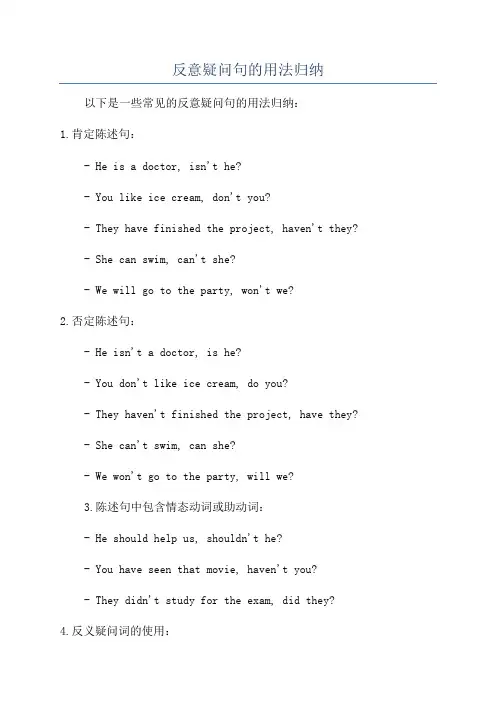
反意疑问句的用法归纳以下是一些常见的反意疑问句的用法归纳:1.肯定陈述句:- He is a doctor, isn't he?- You like ice cream, don't you?- They have finished the project, haven't they?- She can swim, can't she?- We will go to the party, won't we?2.否定陈述句:- He isn't a doctor, is he?- You don't like ice cream, do you?- They haven't finished the project, have they?- She can't swim, can she?- We won't go to the party, will we?3.陈述句中包含情态动词或助动词:- He should help us, shouldn't he?- You have seen that movie, haven't you?- They didn't study for the exam, did they?4.反义疑问词的使用:- He is busy, isn't he?- You can swim, can't you?- She didn't go to the party, did she?总而言之,反意疑问句用来确认或怀疑陈述句中的事实,其构成为陈述句+疑问句部分,根据陈述句的情态动词或助动词来决定动词的形式,并在句末加上否定词或者反义疑问词。
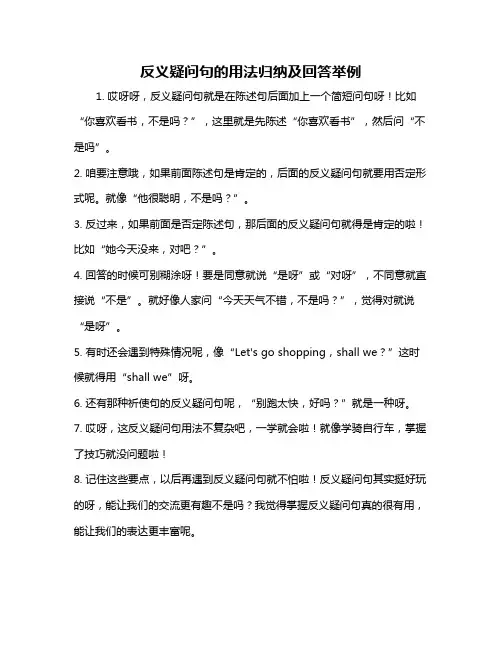
反义疑问句的用法归纳及回答举例
1. 哎呀呀,反义疑问句就是在陈述句后面加上一个简短问句呀!比如“你喜欢看书,不是吗?”,这里就是先陈述“你喜欢看书”,然后问“不是吗”。
2. 咱要注意哦,如果前面陈述句是肯定的,后面的反义疑问句就要用否定形式呢。
就像“他很聪明,不是吗?”。
3. 反过来,如果前面是否定陈述句,那后面的反义疑问句就得是肯定的啦!比如“她今天没来,对吧?”。
4. 回答的时候可别糊涂呀!要是同意就说“是呀”或“对呀”,不同意就直接说“不是”。
就好像人家问“今天天气不错,不是吗?”,觉得对就说“是呀”。
5. 有时还会遇到特殊情况呢,像“Let's go shopping,shall we?”这时候就得用“shall we”呀。
6. 还有那种祈使句的反义疑问句呢,“别跑太快,好吗?”就是一种呀。
7. 哎呀,这反义疑问句用法不复杂吧,一学就会啦!就像学骑自行车,掌握了技巧就没问题啦!
8. 记住这些要点,以后再遇到反义疑问句就不怕啦!反义疑问句其实挺好玩的呀,能让我们的交流更有趣不是吗?我觉得掌握反义疑问句真的很有用,能让我们的表达更丰富呢。
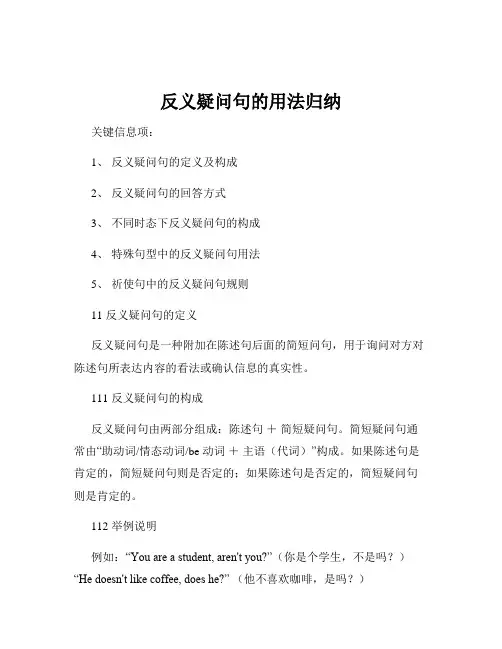
反义疑问句的用法归纳关键信息项:1、反义疑问句的定义及构成2、反义疑问句的回答方式3、不同时态下反义疑问句的构成4、特殊句型中的反义疑问句用法5、祈使句中的反义疑问句规则11 反义疑问句的定义反义疑问句是一种附加在陈述句后面的简短问句,用于询问对方对陈述句所表达内容的看法或确认信息的真实性。
111 反义疑问句的构成反义疑问句由两部分组成:陈述句+简短疑问句。
简短疑问句通常由“助动词/情态动词/be 动词+主语(代词)”构成。
如果陈述句是肯定的,简短疑问句则是否定的;如果陈述句是否定的,简短疑问句则是肯定的。
112 举例说明例如:“You are a student, aren't you?”(你是个学生,不是吗?)“He doesn't like coffee, does he?” (他不喜欢咖啡,是吗?)12 反义疑问句的回答方式回答反义疑问句时,要根据事实情况来回答,而不是根据问句的形式。
如果事实是肯定的,就用 yes 回答;如果事实是否定的,就用 no 回答。
121 肯定回答的情况当陈述句为肯定,反义疑问句为否定时,如果事实是肯定的,回答用 yes。
例如:“You like music, don't you?” (你喜欢音乐,不是吗?)如果确实喜欢音乐,回答应为“Yes, I do” (是的,我喜欢。
)122 否定回答的情况当陈述句为否定,反义疑问句为肯定时,如果事实是否定的,回答用 no。
例如:“You aren't a teacher, are you?” (你不是老师,是吗?)如果确实不是老师,回答应为“No, I'm not” (不,我不是。
)13 不同时态下反义疑问句的构成131 一般现在时如果陈述句的谓语动词是 be 动词,反义疑问句中就用 be 动词的相应形式;如果陈述句的谓语动词是实义动词,反义疑问句中要用助动词 do/does。
例如:“She is beautiful, isn't she?” “He works hard, doesn't he?”132 一般过去时反义疑问句中要用助动词 did。
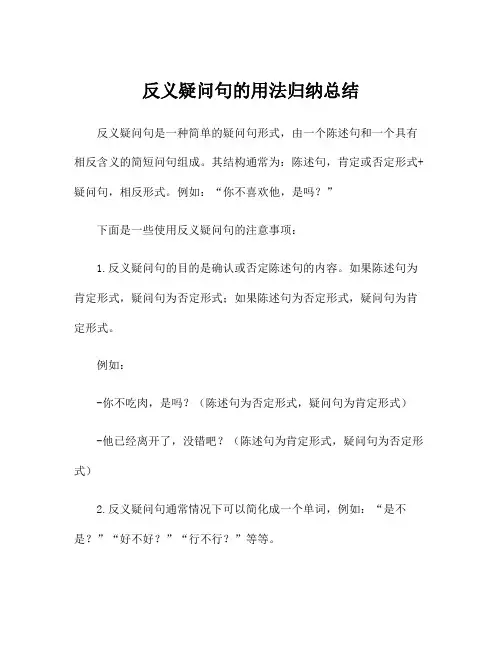
反义疑问句的用法归纳总结反义疑问句是一种简单的疑问句形式,由一个陈述句和一个具有相反含义的简短问句组成。
其结构通常为:陈述句,肯定或否定形式+疑问句,相反形式。
例如:“你不喜欢他,是吗?”
下面是一些使用反义疑问句的注意事项:
1.反义疑问句的目的是确认或否定陈述句的内容。
如果陈述句为肯定形式,疑问句为否定形式;如果陈述句为否定形式,疑问句为肯定形式。
例如:
-你不吃肉,是吗?(陈述句为否定形式,疑问句为肯定形式)-他已经离开了,没错吧?(陈述句为肯定形式,疑问句为否定形式)
2.反义疑问句通常情况下可以简化成一个单词,例如:“是不是?”“好不好?”“行不行?”等等。
3.反义疑问句通常用于口语中,用于询问对方的意见、确认事实
等等。
在正式的文书、学术论文中不适用。
4.如果说陈述句是用强调语气的话,则疑问句会反过来,即疑问
句用的是疑问语气。
例如:
-他真的赢了,是吧?(陈述句用了强调语气,则疑问句要用疑问
语气)
-你认真工作,对吗?(陈述句用了强调语气,则疑问句要用疑问
语气)
5.反义疑问句在不同的区域和地方使用方式可能会有所差异。
在
英国,人们经常在句子末尾加上“innit”,而在美国则较少使用该词。
6.反义疑问句的使用需要注意语气问题,不同的语气会对陈述句
的意义和疑问句的目的产生影响。
常见的语气有肯定语气、否定语气
和委婉语气等等。
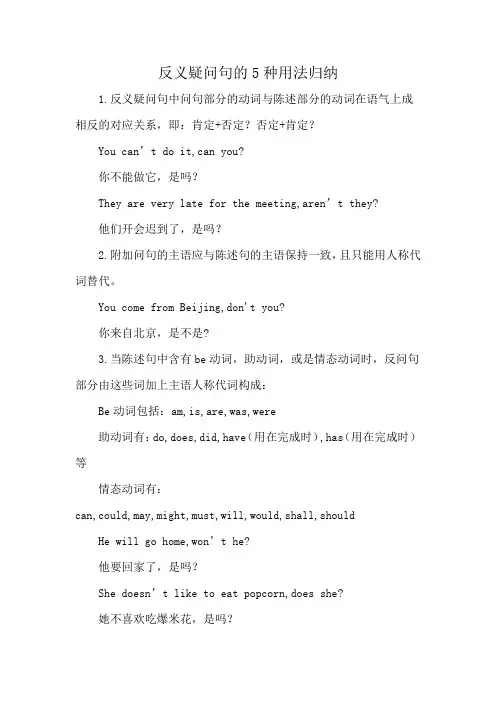
反义疑问句的5种用法归纳1.反义疑问句中问句部分的动词与陈述部分的动词在语气上成相反的对应关系,即:肯定+否定?否定+肯定?You can’t do it,can you?你不能做它,是吗?They are very late for the meeting,aren’t they?他们开会迟到了,是吗?2.附加问句的主语应与陈述句的主语保持一致,且只能用人称代词替代。
You come from Beijing,don't you?你来自北京,是不是?3.当陈述句中含有be动词,助动词,或是情态动词时,反问句部分由这些词加上主语人称代词构成:Be动词包括:am,is,are,was,were助动词有:do,does,did,have(用在完成时),has(用在完成时)等情态动词有:can,could,may,might,must,will,would,shall,should He will go home,won’t he?他要回家了,是吗?She doesn’t like to eat popcorn,does she?她不喜欢吃爆米花,是吗?4.have的不同用法,反义疑问句用不同的动词(1)have表“有”时,反义疑问句谓语动词用have/do都行He has a new car,doesn’t/hasn’t he?(2)have表“吃,喝,玩,度过,举办”等是,反义疑问句谓语动词用doHe has supper at home every day,doesn’t he?They had a good time in Beijing,didn’t they?(3)have to表“不得不,必须”时,反义疑问句谓语动词用doKite has to help her mother,doesn’t she?(4)had better表“最好”时,反义疑问句谓语动词用hadWe had better go to school at once,hadn't we?(5)have用在完成时中,反义疑问句谓语动词用haveThey have known the matter,haven’t they?5.(1)反义疑问句的陈述部分带有little,few,never,hardly,seldom,nobody,nothing,noone,none,neither等否定意义的词时,问句部分用肯定式。
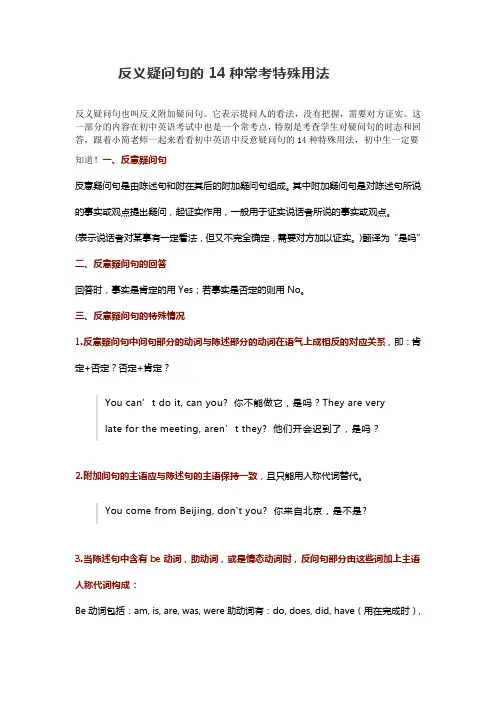
反义疑问句的14种常考特殊用法反义疑问句也叫反义附加疑问句。
它表示提问人的看法,没有把握,需要对方证实。
这一部分的内容在初中英语考试中也是一个常考点,特别是考查学生对疑问句的时态和回答,跟着小简老师一起来看看初中英语中反意疑问句的14种特殊用法,初中生一定要知道!一、反意疑问句反意疑问句是由陈述句和附在其后的附加疑问句组成。
其中附加疑问句是对陈述句所说的事实或观点提出疑问,起证实作用,一般用于证实说话者所说的事实或观点。
(表示说话者对某事有一定看法,但又不完全确定,需要对方加以证实。
)翻译为“是吗”二、反意疑问句的回答回答时,事实是肯定的用Yes;若事实是否定的则用No。
三、反意疑问句的特殊情况1.反意疑问句中问句部分的动词与陈述部分的动词在语气上成相反的对应关系,即:肯定+否定?否定+肯定?You can’t do it, can you? 你不能做它,是吗?They are verylate for the meeting, aren’t they? 他们开会迟到了,是吗?2.附加问句的主语应与陈述句的主语保持一致,且只能用人称代词替代。
You come from Beijing, don't you? 你来自北京,是不是?3.当陈述句中含有be动词,助动词,或是情态动词时,反问句部分由这些词加上主语人称代词构成:Be动词包括:am, is, are, was, were助动词有:do, does, did, have(用在完成时),has(用在完成时)等情态动词有:can, could, may, might, must, will, would, shall, shouldHe will go home, won’t he? 他要回家了,是吗?She doesn’tlike to eat popcorn, does she? 她不喜欢吃爆米花,是吗?4.have的不同用法,反义疑问句用不同的动词(1)have 表“有”时,反义疑问句谓语动词用have/do都行He has a new car, doesn’t/hasn’t he?(2)have表“吃,喝,玩,度过,举办”等是,反义疑问句谓语动词用doHe has supper at home every day, doesn’t he?They had agood time in Beijing, didn’t they?(3)have to表“不得不,必须”时,反义疑问句谓语动词用doKite has to help her mother, doesn’t she?(4)had better表“最好”时,反义疑问句谓语动词用hadWe had better go to school at once, hadn't we?(5)have用在完成时中,反义疑问句谓语动词用haveThey have known the matter, haven’t they?5.(1)反意疑问句的陈述部分带有little, few, never, hardly, seldom,nobody, nothing, no one, none, neither等否定意义的词时,问句部分用肯定式。
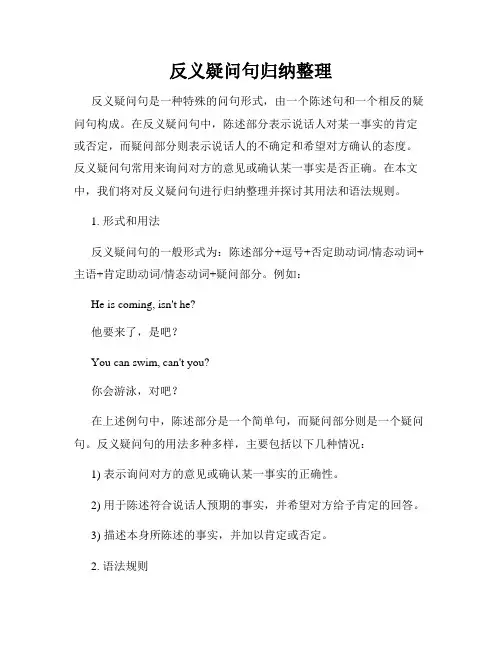
反义疑问句归纳整理反义疑问句是一种特殊的问句形式,由一个陈述句和一个相反的疑问句构成。
在反义疑问句中,陈述部分表示说话人对某一事实的肯定或否定,而疑问部分则表示说话人的不确定和希望对方确认的态度。
反义疑问句常用来询问对方的意见或确认某一事实是否正确。
在本文中,我们将对反义疑问句进行归纳整理并探讨其用法和语法规则。
1. 形式和用法反义疑问句的一般形式为:陈述部分+逗号+否定助动词/情态动词+主语+肯定助动词/情态动词+疑问部分。
例如:He is coming, isn't he?他要来了,是吧?You can swim, can't you?你会游泳,对吧?在上述例句中,陈述部分是一个简单句,而疑问部分则是一个疑问句。
反义疑问句的用法多种多样,主要包括以下几种情况:1) 表示询问对方的意见或确认某一事实的正确性。
2) 用于陈述符合说话人预期的事实,并希望对方给予肯定的回答。
3) 描述本身所陈述的事实,并加以肯定或否定。
2. 语法规则在构成反义疑问句的过程中,需要遵循一些语法规则,以确保句子的正确性和逻辑性。
2.1 句子主语在反义疑问句中,疑问部分的主语通常与陈述部分一致。
例如:She likes ice cream, doesn't she?她喜欢冰淇淋,对吧?You have finished your homework, haven't you?你完成了作业,是吧?2.2 肯定和否定疑问部分的肯定或否定助动词/情态动词取决于陈述部分的肯定或否定。
如果陈述部分是肯定的,疑问部分的助动词/情态动词是否定形式,反之亦然。
例如:He doesn't like chocolate, does he?他不喜欢巧克力,对吧?They can't swim, can they?他们不会游泳,是吧?2.3 时态和语态反义疑问句的时态和语态一般与陈述部分保持一致。
例如:She has been to Paris, hasn't she?她去过巴黎,是吧?The book wasn't written by him, was it?这本书不是他写的,对吧?3. 总结反义疑问句是一种特殊的问句形式,常用来询问对方的意见或确认某一事实的正确性。
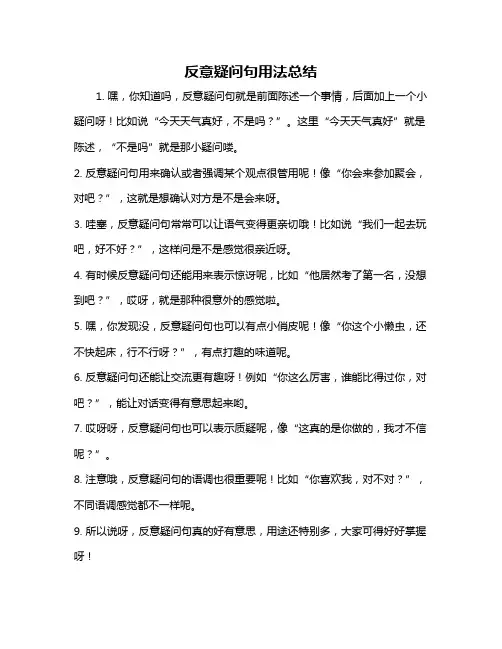
反意疑问句用法总结
1. 嘿,你知道吗,反意疑问句就是前面陈述一个事情,后面加上一个小疑问呀!比如说“今天天气真好,不是吗?”。
这里“今天天气真好”就是陈述,“不是吗”就是那小疑问喽。
2. 反意疑问句用来确认或者强调某个观点很管用呢!像“你会来参加聚会,对吧?”,这就是想确认对方是不是会来呀。
3. 哇塞,反意疑问句常常可以让语气变得更亲切哦!比如说“我们一起去玩吧,好不好?”,这样问是不是感觉很亲近呀。
4. 有时候反意疑问句还能用来表示惊讶呢,比如“他居然考了第一名,没想到吧?”,哎呀,就是那种很意外的感觉啦。
5. 嘿,你发现没,反意疑问句也可以有点小俏皮呢!像“你这个小懒虫,还不快起床,行不行呀?”,有点打趣的味道呢。
6. 反意疑问句还能让交流更有趣呀!例如“你这么厉害,谁能比得过你,对吧?”,能让对话变得有意思起来哟。
7. 哎呀呀,反意疑问句也可以表示质疑呢,像“这真的是你做的,我才不信呢?”。
8. 注意哦,反意疑问句的语调也很重要呢!比如“你喜欢我,对不对?”,不同语调感觉都不一样呢。
9. 所以说呀,反意疑问句真的好有意思,用途还特别多,大家可得好好掌握呀!
我觉得反意疑问句真的是让语言变得丰富又有趣的好东西,大家一定要多运用呀!。
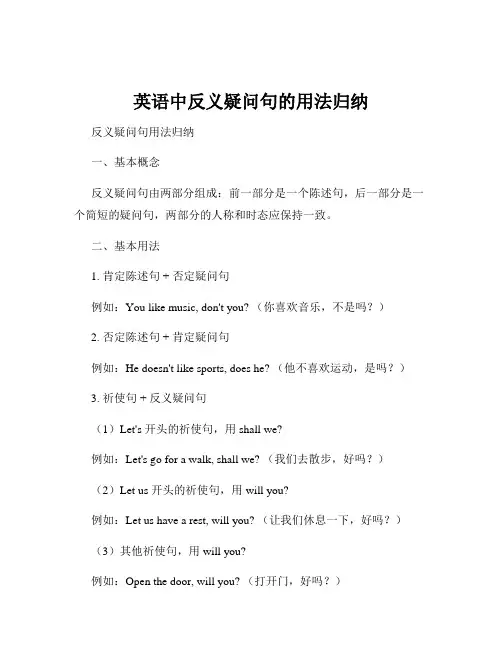
英语中反义疑问句的用法归纳反义疑问句用法归纳一、基本概念反义疑问句由两部分组成:前一部分是一个陈述句,后一部分是一个简短的疑问句,两部分的人称和时态应保持一致。
二、基本用法1. 肯定陈述句 + 否定疑问句例如:You like music, don't you? (你喜欢音乐,不是吗?)2. 否定陈述句 + 肯定疑问句例如:He doesn't like sports, does he? (他不喜欢运动,是吗?)3. 祈使句 + 反义疑问句(1)Let's 开头的祈使句,用 shall we?例如:Let's go for a walk, shall we? (我们去散步,好吗?)(2)Let us 开头的祈使句,用 will you?例如:Let us have a rest, will you? (让我们休息一下,好吗?)(3)其他祈使句,用 will you?例如:Open the door, will you? (打开门,好吗?)4. 含有 must 的反义疑问句(1)must 表示“必须”时,用 needn't例如:You must finish your homework today, needn't you? (你今天必须完成作业,不是吗?)(2)must 表示推测“一定,肯定”时,根据实际情况而定例如:He must be very tired, isn't he? (他一定很累了,不是吗?)5. 含有否定词的反义疑问句当陈述句中有 never, few, little, nothing, nobody 等否定词时,反义疑问句用肯定形式。
例如:There is nothing in the box, is there? (盒子里什么都没有,是吗?)三、固定搭配1. “I am + 表语”,反义疑问句用“aren't I”例如:I'm late, aren't I? (我迟到了,不是吗?)2. 陈述部分是“there be”结构,反义疑问句用“be there”例如:There is a book on the desk, isn't there? (桌子上有一本书,不是吗?)3. 当陈述部分主语是不定代词 everyone, somebody, nobody, everyone 等时,反义疑问句用 they 或 he例如:Everyone is here, aren't they? (大家都在这儿,不是吗?)4. 当陈述部分主语是 this, that 时,反义疑问句用 it;当陈述部分主语是 these, those 时,反义疑问句用 they例如:This is a pen, isn't it? (这是一支钢笔,不是吗?)5. 当陈述部分是主从复合句时,反义疑问句与主句的主语和谓语保持一致例如:He said he would come, didn't he? (他说他会来,不是吗?)双语例句:1. I have a lot of friends, don't I? (我有很多朋友,不是吗?)2. She doesn't speak French, does she? (她不会说法语,是吗?)3. Have a cup of coffee, will you? (喝杯咖啡,好吗?)4. We should study hard, shouldn't we? (我们应该努力学习,不是吗?)5. They have been to Beijing, haven't they? (他们去过北京,不是吗?)6. You aren't a doctor, are you? (你不是医生,对吧?)7. There are some apples on the tree, aren't there? (树上有一些苹果,不是吗?)8. Nobody knows the answer, do they? (没人知道答案,对吧?)9. This isn't your book, is it? (这不是你的书,对吧?)10. Those are beautiful flowers, aren't they? (那些是漂亮的花,不是吗?)11. He can swim very well, can't he? (他游泳游得很好,不是吗?)12. She never tells lies, does she? (她从不说谎,对吧?)13. We had a great time yesterday, didn't we? (我们昨天玩得很开心,不是吗?)14. If it rains tomorrow, we won't go hiking, will we? (如果明天下雨,我们就不去徒步了,对吧?)15. You think he is right, don't you? (你认为他是对的,不是吗?)16. Mary has few friends here, does she? (玛丽在这儿几乎没朋友,对吧?)17. The boy doesn't like vegetables, does he? (这男孩不喜欢蔬菜,是吗?)18. Everyone wants to be happy, don't they? (每个人都想快乐,不是吗?)19. I'm a good student, aren't I? (我是个好学生,不是吗?)20. He told you the truth, didn't he? (他告诉你真相了,不是吗?)。
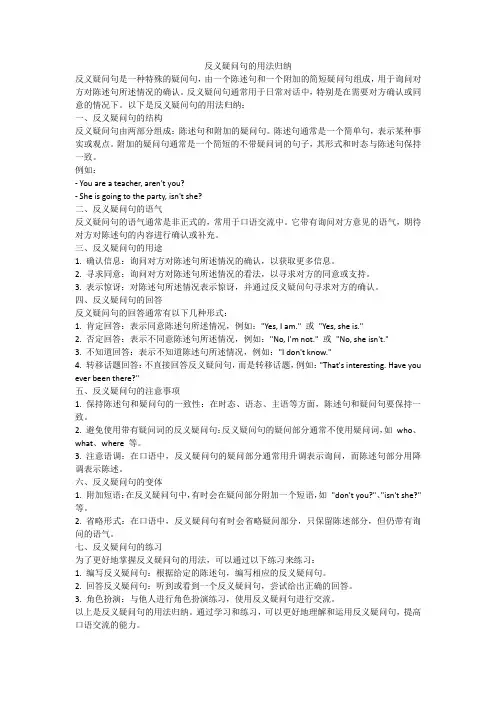
反义疑问句的用法归纳反义疑问句是一种特殊的疑问句,由一个陈述句和一个附加的简短疑问句组成,用于询问对方对陈述句所述情况的确认。
反义疑问句通常用于日常对话中,特别是在需要对方确认或同意的情况下。
以下是反义疑问句的用法归纳:一、反义疑问句的结构反义疑问句由两部分组成:陈述句和附加的疑问句。
陈述句通常是一个简单句,表示某种事实或观点。
附加的疑问句通常是一个简短的不带疑问词的句子,其形式和时态与陈述句保持一致。
例如:- You are a teacher, aren't you?- She is going to the party, isn't she?二、反义疑问句的语气反义疑问句的语气通常是非正式的,常用于口语交流中。
它带有询问对方意见的语气,期待对方对陈述句的内容进行确认或补充。
三、反义疑问句的用途1. 确认信息:询问对方对陈述句所述情况的确认,以获取更多信息。
2. 寻求同意:询问对方对陈述句所述情况的看法,以寻求对方的同意或支持。
3. 表示惊讶:对陈述句所述情况表示惊讶,并通过反义疑问句寻求对方的确认。
四、反义疑问句的回答反义疑问句的回答通常有以下几种形式:1. 肯定回答:表示同意陈述句所述情况,例如:"Yes, I am." 或"Yes, she is."2. 否定回答:表示不同意陈述句所述情况,例如:"No, I'm not." 或"No, she isn't."3. 不知道回答:表示不知道陈述句所述情况,例如:"I don't know."4. 转移话题回答:不直接回答反义疑问句,而是转移话题,例如:"That's interesting. Have you ever been there?"五、反义疑问句的注意事项1. 保持陈述句和疑问句的一致性:在时态、语态、主语等方面,陈述句和疑问句要保持一致。
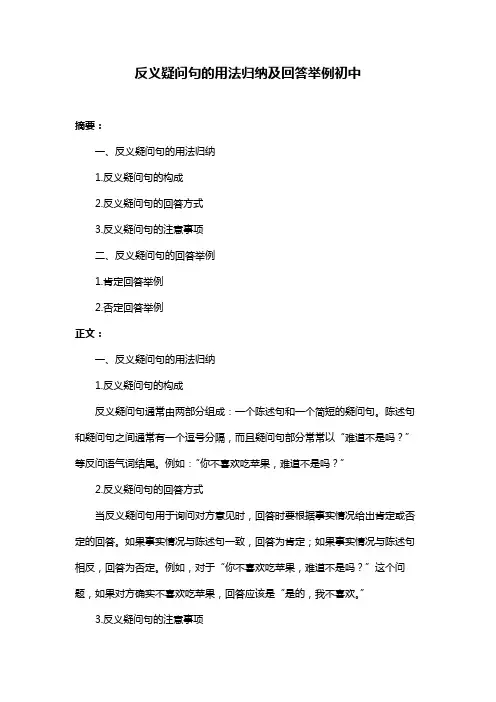
反义疑问句的用法归纳及回答举例初中
摘要:
一、反义疑问句的用法归纳
1.反义疑问句的构成
2.反义疑问句的回答方式
3.反义疑问句的注意事项
二、反义疑问句的回答举例
1.肯定回答举例
2.否定回答举例
正文:
一、反义疑问句的用法归纳
1.反义疑问句的构成
反义疑问句通常由两部分组成:一个陈述句和一个简短的疑问句。
陈述句和疑问句之间通常有一个逗号分隔,而且疑问句部分常常以“难道不是吗?”等反问语气词结尾。
例如:“你不喜欢吃苹果,难道不是吗?”
2.反义疑问句的回答方式
当反义疑问句用于询问对方意见时,回答时要根据事实情况给出肯定或否定的回答。
如果事实情况与陈述句一致,回答为肯定;如果事实情况与陈述句相反,回答为否定。
例如,对于“你不喜欢吃苹果,难道不是吗?”这个问题,如果对方确实不喜欢吃苹果,回答应该是“是的,我不喜欢。
”
3.反义疑问句的注意事项
在使用反义疑问句时,要注意陈述句和疑问句的一致性。
如果陈述句是肯定形式,疑问句部分也应该是肯定形式;如果陈述句是否定形式,疑问句部分也应该是否定形式。
此外,反义疑问句通常用于表示对某事不确定或想要得到对方确认的情况下,所以要根据实际情况适当使用。
二、反义疑问句的回答举例
1.肯定回答举例
张三问:“你不喜欢吃苹果,难道不是吗?”
李四回答:“是的,我不喜欢。
”
2.否定回答举例
张三问:“你不喜欢吃苹果,难道不是吗?”
李四回答:“不,我喜欢吃苹果。
反义疑问句的用法归纳及回答举例说明反义疑问句是一种特殊的问句形式,由两部分组成:一个陈述句部分和一个疑问句部分。
两部分之间通过连接词或连接词组连接,一部分为陈述句的肯定形式,另一部分为疑问句的否定形式。
反义疑问句主要用于表示对已知事实的确认或否定,请求对方进行肯定或否定的回答。
本文将对反义疑问句的用法进行归纳及举例说明。
1. 反义疑问句的结构反义疑问句主要由陈述句和疑问句两部分构成,它们之间通过连接词或连接词组连接起来。
陈述句部分是一个肯定句,疑问句部分则是一个否定句。
陈述句部分的肯定形式可以包括肯定动词、肯定形容词或副词等,而疑问句部分的否定形式则是通过将否定词或短语添加到原来的陈述句中来表达。
常用的连接词或连接词组有:isn't it, don't you, won't you, haven't you等。
2. 反义疑问句的用法2.1 确认陈述句反义疑问句常用于确认陈述句的真实性或请求对方确认陈述句。
在这种情况下,陈述句的肯定形式和疑问句的否定形式表示同一个事实。
例如:- You are a student, aren't you?(你是学生,对不对?)- It's a beautiful day, isn't it?(这是个美好的一天,是吧?)2.2 否定陈述句反义疑问句还可以用于否定陈述句,表示对陈述句的否定或期待对方的肯定。
例如:- He doesn't like coffee, does he?(他不喜欢咖啡,对吗?)- You can't swim, can you?(你不会游泳,对吧?)2.3 请求建议或请求反义疑问句还可以用于请求建议或请求对方的肯定回答。
例如:- Let's go for a walk, shall we?(咱们出去散散步,好吗?)- Don't forget to bring your umbrella, will you?(别忘了带上你的雨伞,行吗?)3. 反义疑问句的回答针对反义疑问句的回答,通常有两种情况:一种是前半句和后半句的信息一致,另一种是前半句和后半句的信息不一致。
反义疑问句用法(最新全)1.反义疑问句的用法当陈述句的主语为anybody。
anyone。
everybody。
everyone。
___。
someone。
nobody。
no one时,反意疑问句的主语用they。
但是,当nobody。
no one等作主语时,可以使用he,尤其是具有否定概念时。
例如:有人在我出去的时候打电话了,是吗?派对上每个人都很开心,是吗?没有人想去那里,是吗?没有人谈论这件事,是吗?昨天有人借了你的自行车,是吗?任何人都可以做到,是吗?2.当陈述部分的主语是I,而句子又用来征询对方的意见时,附加疑问句中的主语用you。
例如:我觉得英语很有趣,你觉得呢?我不喜欢那部电影,你呢?3.当陈述句的主语为everything。
anything。
nothing。
something等时,反意疑问句的主语用it。
例如:一切都好,是吗?没有什么可以阻止我们前进,是吗?4.当陈述部分的主语是指示代词this。
that或these。
those 时,附加疑问句中的主语分别用it和they。
例如:这很重要,是吗?那不正确,是吗?这些是你的朋友___和___,是吗?5.当陈述句的主语为one时,在正式情况下反义疑问句的主语用one,在非正式情况下用you。
例如:人们应该向别人研究,不是吗?人不能成为自己的主人,是吗?When ___ such as "had better," "would rather," "would like,"or "ought to," the tag n should use the corresponding auxiliary verb。
For example。
"You'd better go now。
hadn't you?" or "He'd like to go there。
反义疑问句的用法归纳1. 引言反义疑问句作为英语语法中的一种表达形式,被广泛使用于口语和书面语中。
它能够用简洁的方式表示询问和确认对方观点或行为的真实性。
在本文中,我们将总结反义疑问句的用法,并探讨其在不同情境下的应用。
2. 反义疑问句的基本结构反义疑问句由一个主陈述句和附加一小问构成。
主陈述句以肯定或否定形式表达某个观点或行为,而附加一小问则相反,以相反形式来确认或验证主陈述句。
通常情况下,如果主陈述句是肯定形式,则附加一小问是否定形式;如果主陈述句是否定形式,则附加一小问是肯定形式。
3. 反义疑问句的基本用法3.1 确认对方观点当我们想要确认对方表达的观点时,可以使用反义疑问句来获得确定性答案。
例子:- You like coffee, don't you?(你喜欢咖啡,是吧?)- She couldn't come to the party, could she?(她没能来参加聚会,是吧?)3.2 确认对方行为反义疑问句可以用来确认或核实对方的行为或态度。
例子:- You've finished your homework, haven't you?(你已经完成作业了,对吗?)- He won't be late, will he?(他不会迟到,对吧?)3.3 请求、邀请与建议反义疑问句还可用于表达请求、邀请和建议等。
例子:- Let's go for a walk, shall we?(我们出去散个步,好吗?)- Open the window, will you?(请你把窗户打开,好吗?)4. 特殊情况下的反义疑问句4.1 副词“never”当主陈述句中包含表示否定的副词“never”时,附加一小问部分通常使用肯定形式。
例子:- You never visit me, do you?(你从不来看我呢,是吧?)4.2 否定动词及短语主陈述句中包含否定动词或短语时,附加一小问部分通常使用肯定形式。
反义疑问句的用法归纳及回答【反义疑问句】(一)概念:反意疑问句是由陈述句和附在其后的附加疑问句组成。
其中附加疑问句是对陈述句所说的事实或观点提出疑问,起证实作用,一般用于证实说话者所说的事实或观点。
(二)要点注意:1、反意疑问句前后两部分谓语应是:“肯定陈述+否定疑问”或“否定陈述+肯定疑问”。
2、简略问句如果是否定式:not应与be,do,will等系动词、助动词、情态动词缩写。
3、简略问句的主语不用名词,应用人称代词。
4、陈述部分含“too...to”时,是否定句。
(三)用法:1) 陈述部分I am时,疑问部分要用aren't I.I'm as tall as your sister,aren't I?(我和你姐姐一样高,对吗?)2) 陈述部分用no, nothing, nobody, never, few, little, seldom, hardly等否定含义的词时,疑问部分用肯定含义。
如:The old man made no answer, did he?Jim is never late for school, is he?3) 陈述部分有情态动词have to +v. (had to + v.),疑问部分常用don't +主语(didn't +主语)。
We have to get there at eight tomorrow, don't we?used to,疑问部分用didn't +主语或usedn't +主语。
He used to take pictures there, didn't he? / usedn't he?had better(最好)+ v. 疑问句部分用hadn't you?You'd better read it by yourself, hadn't you?4) 陈述部分有would rather(宁可、宁愿)+v.,疑问部分多用wouldn't +主语。
反义疑问句的用法反义疑问句的用法如下:1、当陈述句的主语为anybody, anyone, everybody, everyone, somebody, someone, nobody, no one时,反意疑问句的主语用they。
也可用he,尤其是nobody, no one 等作主语,具有否定概念时。
如:Somebody phoned while I was out, didn’t they?Everyone enjoyed the party, didn’t they?Nobody wants to go there, does he?Nobody says a word about the incident, don’t they?Somebody borrowed your bike yesterday, didn’t they?Anybody can do it, can’t they?2、当陈述部分的主语是I,而句子又用来征询对方的意见时,附加疑问句中的主语用you。
如:I find English very interesting, don’t you?I don’t like that film, do you?3、当陈述句的主语为everything, anything, nothing, something等时,反意疑问句的主语用it.如:Everything is all right, isn’t it?Nothing can stop us going forward, can it?4、当陈述部分的主语是指示代词this, that或these, those时,附加疑问句中的主语分别用it和they。
如:This is important, i sn’t it?That isn’t correct, is it?These are your friends Tom and Jack, aren’t they?5、当陈述句的主语为one时, 反意疑问句的主语在正式情况下用one;在非正式情况下用you.如:One should learn from others, shouldn’t one / you?One can’t be one’s own master, can one?One can not be too careful, can one?6、当陈述句的谓语部分含有had better, would rather, would like, ought to时, 反意疑问句的谓语用相应的助动词。
反意疑问句用法完全归纳一、基本用法与结构反意疑问句由“陈述句+简略疑问句”两部分组成,第一部分提出一种看法,第二部分用来质疑或表示证实。
陈述部分与疑问部分的动词时态和动词性质应保持一致,而且肯定和否定形式彼此相反,即陈述部分为肯定式时,疑问部分用否定式,陈述部分为否定式时,疑问部分用肯定式:He likes English, doesn ’t he? 他喜欢英语,是吗?He doesn ’t like English, does he? 他不喜欢英语,是吗?【注】1. 若陈述部分含有seldom, hardly, never, few, nothing 等否定词或半否定词,其疑问部分要用肯式:He has few friends here, has he? 他在这儿几乎没什么朋友,是吗?She said nothing, did she? 她什么也没说,是不是?2. 若陈述部分含有带否定前缀的词,疑问部分仍用否定式:It is unfair, isn ’t it? 这不公平,不是吗?It is impossible, isn ’t it? 那是不可能的,是吗 ?二、反意疑问句的主语问题1.基本原则:疑问部分的主语应与陈述部分主语一致,且只能是代词:Mary is a nurse, isn’t she? 玛丽是护士,对吗?2.当陈述部分为there be 句型时,疑问部分仍用there 作“主语”:There was nothing in the room, was there? 房间里什么也没有,是吗?3.当陈述部分的主语是指示代词时,疑问部分用it, they 等代词:That is a new car, isn ’t it? 这是一辆新汽车,是吗?4.当陈述部分的主语是复合不定代词时,若陈述部分的主语为somebody, someone, everyone, everybody, no one, nobody 等复合不定代词,其反意疑问句的主语在正式文体中用he ,在口语或非正式文体中通常用they :Nobody was late, were they? 没有一个人迟到,是吗 ?5.当陈述部分的主语是something, anything, nothing, everything 等复合不定代词时,其反意疑问句的主语要用it:Everything is ready, isn ’t it? 一切都准备好了吗?Nothing is important, is it? 没有什么重要的,不是吗 ?三、陈述部分有动词 have 的反意疑问句1.当have 为助动词时,其反意疑问句沿用同样的助动词:He has already left, hasn ’t he? 他已经离开了,是吗 ?2.当 have 为实意动词时,要分两种情况:①若表示“所有”,反意疑问句可以用h ave,也可以用do:He has a lot of friends here, hasn ’t [doesn ’t] he? 他在这儿有许多朋友,是吗?但是若陈述部分用的是have 的否定式,反意疑问句用have 还是用 do,取决于陈述部分的动词形式:He hasn ’t any money, has he? 他没有钱,是吗 ?He doesn ’t have any money, does he? 他没有钱,是吗 ?②若表示“吃”、“玩”等意思,反意疑问句要用do:He has supper at 5, doesn ’t he? 他 5 点吃晚餐,是吗 ?He had a good time at the party, didn ’t he? 他在晚会上玩得很开心,是吗 ?3.当用于have to 时,通常也有两种可能:若表示经常性的行为,则多用加助动词do 的形式;若表示特定的行为,则多用have :He often has to get up early, doesn ’t he? 他经常要早起,是吗?He has to go to bed late tonight, hasn ’t he? 他今晚要迟睡,是吗 ?四、含情态动词的反意疑问句1.基本原则:在通常情况下,当陈述部分含有情态动词时,疑问部分会重复前面同样的情态动词:He can speak English, can ’t he ?他会说英语,是吗?Weshouldn ’t go, s hould we? 我们不应该去,对不对?2.当陈述部分含有must 时,要分两种情况:①若must表示“必须”或“有必要”,疑问部分用mustn’t或needn’t:Y ou must leave at once, mustn ’t [needn ’t] you? 你必须(有必要) 马上离开,是吗 ?但是若陈述部分有 mustn ’t 表示禁止,疑问部分要must :Y ou mustn ’t laugh, must you? 你不准笑,知道吗 ?② 若 must 表示推测,疑问部分不能用 must ,而应根据 must 后的动词结构采用相应的动词形式:He must be tired, isn ’t he? 他一定累了,是吗 ?五、陈述部分为祈使句的反意疑问句1.基本原则:若陈述部分为祈使句,疑问部分通常用will you :Please help us, will you? 请帮帮我们,好吗?Come with us, will you? 同我们一起去,好吗?Don’t forget to p ost the le t t er, will you? 请别忘了寄信。
反意疑问句用法完全归纳一、基本用法与结构反意疑问句由“陈述句+简略疑问句”两部分组成,第一部分提出一种看法,第二部分用来质疑或表示证实。
陈述部分与疑问部分的动词时态和动词性质应保持一致,而且肯定和否定形式彼此相反,即陈述部分为肯定式时,疑问部分用否定式,陈述部分为否定式时,疑问部分用肯定式:He likes English, doesn't he? 他喜欢英语,是吗?He doesn't like English, does he? 他不喜欢英语,是吗?【注】1. 若陈述部分含有seldom, hardly, never, few, nothing 等否定词或半否定词,其疑问部分要用肯式:He has few friends here, has he? 他在这儿几乎没什么朋友,是吗?She said nothing, did she? 她什么也没说,是不是?2.若陈述部分含有带否定前缀的词,疑问部分仍用否定式:It is unfair, isn't it? 这不公平,不是吗?It is impossible, isn't it? 那是不可能的,是吗?二、反意疑问句的主语问题1.基本原则:疑问部分的主语应与陈述部分主语一致,且只能是代词:Maryis a nurse, isn't she? 玛丽是护士,对吗?2. 当陈述部分为there be 句型时,疑问部分仍用there 作“主语”:Therewas nothing in the room, was there? 房间里什么也没有,是吗?3. 当陈述部分的主语是指示代词时,疑问部分用it, they 等代词:That is a new car, isn't it? 这是一辆新汽车,是吗?4. 当陈述部分的主语是复合不定代词时,若陈述部分的主语为somebody, someone, everyone, everybody, no one, nobody 等复合不定代词,其反意疑问句的主语在正式文体中用he,在口语或非正式文体中通常用they:Nobody was late, were they? 没有一个人迟到,是吗?5.当陈述部分的主语是something, anything, nothing, everything 等复合不定代词时,其反意疑问句的主语要用it:Everything is ready, isn't it? 一切都准备好了吗?Nothing is important, is it? 没有什么重要的,不是吗?三、陈述部分有动词have 的反意疑问句1. 当have 为助动词时,其反意疑问句沿用同样的助动词:He has already left, hasn't he? 他已经离开了,是吗?2.当have 为实意动词时,要分两种情况:① 若表示“所有”,反意疑问句可以用have ,也可以用do:He has a lot of friends here, hasn't [doesn't] he? 他在这儿有许多朋友,是吗?但是若陈述部分用的是have 的否定式,反意疑问句用have 还是用do,取决于陈述部分的动词形式:He hasn't any money, has he? 他没有钱,是吗?He doesn't have any money, does he? 他没有钱,是吗?② 若表示“吃”、“ 玩”等意思,反意疑问句要用do:He has supper at 5, doesn't he? 他5 点吃晚餐,是吗?He had a good time at the party, didn't he? 他在晚会上玩得很开心,是吗?3.当用于have to时,通常也有两种可能:若表示经常性的行为,则多用加助动词do 的形式;若表示特定的行为,则多用have:He often has to get up early, doesn't he? 他经常要早起,是吗?He has to go to bed late tonight, hasn't he? 他今晚要迟睡,是吗?四、含情态动词的反意疑问句1. 基本原则:在通常情况下,当陈述部分含有情态动词时,疑问部分会重复前面同样的情态动词:He can speak English, can't he?他会说英语,是吗?We shouldn't go, should we? 我们不应该去,对不对?2. 当陈述部分含有must 时,要分两种情况:① 若must 表示“必须”或“有必要”,疑问部分用mustn't 或needn't :You must leave at once, mustn't [needn't] you? 你必须(有必要)马上离开,是吗? 但是若陈述部分有mustn't 表示禁止,疑问部分要must :You mustn't laugh, must you? 你不准笑,知道吗?② 若must表示推测,疑问部分不能用must,而应根据must 后的动词结构采用相应的动词形式:He must be tired, isn't he? 他一定累了,是吗?五、陈述部分为祈使句的反意疑问句1. 基本原则:若陈述部分为祈使句,疑问部分通常用will you:Please help us, will you? 请帮帮我们,好吗?Come with us, will you? 同我们一起去,好吗?Don't forget to post the letter, will you? 请别忘了寄信。
2. 当祈使句为Let's 时,疑问部分总是用shall we:Let's go there together, shall we? 我们一起去,好吗?Let's sit under the tree, shall we? 咱们就坐这树下吧,好不好?3. 当祈使句为Let us…时,若表示请求,疑问部分用will you,若表示建议,疑问部分用shall we:Let us know your address, will you? 请把你的地址告诉我们,好吗?Let us go swimming together, shall we? 我们一起去游泳好吗?六、陈述部分为主从复合句的反意疑问句1. 当陈述部分为主从复合句【主句+从句】时,疑问部分一般应与主句保持一致:He said that he didn't like it, didn't he? 他说他不喜欢它,是不是?He knows where I live, doesn't he? 他知道我住什么地方,是不是?2. 当陈述部分为I think (believe, suppose) that...等时,疑问部分通常与从句保持一致(注意否定的转移):I think that it is too short, isn't it? 我认为它太短了,对不对(它太短吗)?I don't think he will come, will he? 我认为他不会来,对吗(他会来吗)? 【注】这类用法主要限于主语为第一人称且think 等动词为一般现在时的情形。
七、反意疑问句其他几种用法1. 当陈述部分是I'm 时,疑问部分通常用aren't :I'm wrong, aren't ? 我错了,是吗I'm older than you, aren't ? 我年纪比你大,对不对?2. 当陈述部分是I wish…时,疑问部分通常用may II wish to go with them, may I? 我想同他们一起去,可以吗?3. 当陈述部分有had better 时,疑问部分用had:He'd better leave here, hadn't he? 他最好离开这儿,是吗?4.含有ought to 的反意疑问句,陈述部分是肯定的,疑问部分用shouldn't / oughtn't +主语。
He ought to know what to do, oughtn't he? / shouldn't he? 他应该知道怎么做,不是吗?5. 陈述部分的谓语是used to 时,疑问部分用didn't +主语或usedn't +主语。
He used to take pictures there, didn't he? / usedn't he?6.陈述部分有would rather +v.,疑问部分多用wouldn't +主语。
He would rather read it ten times than recite it, wouldn't he?7. 陈述部分有You'd like to +v. 疑问部分用wouldn't +主语。
You'd like to go with me, wouldn't you?8 . 感叹句中,疑问部分用be + 主语。
What colours, aren't they?What a smell, isn't it?9. 陈述部分由neither… nor, either… or 连接的并列主语时,疑问部分根据其实际逻辑意义而定。
Neither you nor I am engineer, are we?10.并列复合句疑问部分,谓语动词根据邻近从句的谓语而定。
Mr. Smith had been to Beijing for several times, he should have been in China now, shouldn'the?11.带情态动词dare 或need 的反意疑问句,疑问部分常用need (dare ) +主语。
We need not do it again, need we ?He dare not say so, dare you?当dare, need 为实义动词时,疑问部分用助动词do + 主语。
She doesn't dare to go home alone, does she?12. 当陈述部分以one不定代词做主语时,附加问句的主语在正式常场用one,非正式场合用he。